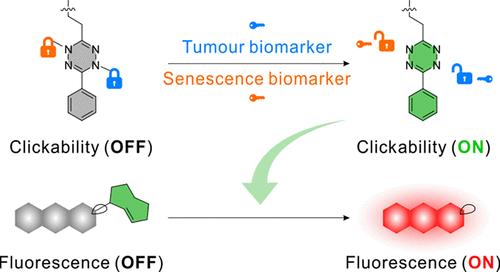当前位置:
X-MOL 学术
›
J. Am. Chem. Soc.
›
论文详情
Our official English website, www.x-mol.net, welcomes your
feedback! (Note: you will need to create a separate account there.)
Dual-Locked Enzyme-Activatable Bioorthogonal Fluorescence Turn-On Imaging of Senescent Cancer Cells
Journal of the American Chemical Society ( IF 14.4 ) Pub Date : 2024-08-05 , DOI: 10.1021/jacs.4c07286
Xinzhu Wang 1 , Si Si Liew 1 , Jingsheng Huang 1 , Yuxuan Hu 1 , Xin Wei 1 , Kanyi Pu 1, 2
Journal of the American Chemical Society ( IF 14.4 ) Pub Date : 2024-08-05 , DOI: 10.1021/jacs.4c07286
Xinzhu Wang 1 , Si Si Liew 1 , Jingsheng Huang 1 , Yuxuan Hu 1 , Xin Wei 1 , Kanyi Pu 1, 2
Affiliation

|
Bioorthogonal pretargeting optical imaging shows the potential for enhanced diagnosis and prognosis. However, the bioorthogonal handles, known for being “always reactive”, may engage in reactions at unintended sites with their counterparts, resulting in nonspecific fluorescence activation and diminishing detection specificity. Meanwhile, despite the importance of detecting senescent cancer cells in cancer therapy, current methods mainly rely on common single senescence-associated biomarkers, which lack specificity for differentiating between various types of senescent cells. Herein, we report a dual-locked enzyme-activatable bioorthogonal fluorescence (DEBOF) turn-on imaging approach for the specific detection of senescent cancer cells. A dual-locked bioorthogonal targeting agent (DBTA) and a bioorthogonally activatable fluorescent imaging probe (BAP) are synthesized as the biorthogonal pair. DBTA is a tetrazine derivative dually caged by two enzyme-cleavable moieties, respectively, associated with senescence and cancer, which ensures that its bioorthogonal reactivity (“clickability”) is only triggered in the presence of senescent cancer cells. BAP is a fluorophore caged by trans-cyclooctane (TCO), whose fluorescence is only activated upon bioorthogonal reaction between its TCO and the decaged tetrazine of DBTA. As such, the DEBOF imaging approach differentiates senescent cancer cells from nonsenescent cancer cells or other senescent cells, allowing noninvasive tracking of the population fluctuation of senescent cancer cells in the tumor of living mice to guide cancer therapies. This study thus provides a general molecular strategy for biomarker-activatable in vivo bioorthogonal pretargeting imaging with the potential to be applied to other imaging modalities beyond optics.
中文翻译:

衰老癌细胞的双锁酶激活生物正交荧光开启成像
生物正交预靶向光学成像显示出增强诊断和预后的潜力。然而,以“总是反应性”而闻名的生物正交手柄可能会在非预期位点与其对应物发生反应,导致非特异性荧光激活并降低检测特异性。同时,尽管检测衰老癌细胞在癌症治疗中很重要,但目前的方法主要依赖于常见的单一衰老相关生物标志物,缺乏区分各种类型衰老细胞的特异性。在此,我们报告了一种双锁酶激活生物正交荧光(DEBOF)开启成像方法,用于特异性检测衰老癌细胞。合成双锁生物正交靶向剂(DBTA)和生物正交可激活荧光成像探针(BAP)作为双正交对。 DBTA 是一种四嗪衍生物,由两个酶可裂解部分双重包裹,分别与衰老和癌症相关,这确保了其生物正交反应性(“可点击性”)仅在衰老癌细胞存在时才会触发。 BAP 是一种被反式环辛烷 (TCO) 笼蔽的荧光团,其荧光仅在其 TCO 与 DBTA 的脱笼四嗪之间发生生物正交反应时才会被激活。因此,DEBOF成像方法将衰老癌细胞与非衰老癌细胞或其他衰老细胞区分开来,从而可以无创地跟踪活体小鼠肿瘤中衰老癌细胞的群体波动,以指导癌症治疗。 因此,这项研究为生物标志物可激活的体内生物正交预靶向成像提供了通用的分子策略,并有可能应用于光学以外的其他成像方式。
更新日期:2024-08-05
中文翻译:

衰老癌细胞的双锁酶激活生物正交荧光开启成像
生物正交预靶向光学成像显示出增强诊断和预后的潜力。然而,以“总是反应性”而闻名的生物正交手柄可能会在非预期位点与其对应物发生反应,导致非特异性荧光激活并降低检测特异性。同时,尽管检测衰老癌细胞在癌症治疗中很重要,但目前的方法主要依赖于常见的单一衰老相关生物标志物,缺乏区分各种类型衰老细胞的特异性。在此,我们报告了一种双锁酶激活生物正交荧光(DEBOF)开启成像方法,用于特异性检测衰老癌细胞。合成双锁生物正交靶向剂(DBTA)和生物正交可激活荧光成像探针(BAP)作为双正交对。 DBTA 是一种四嗪衍生物,由两个酶可裂解部分双重包裹,分别与衰老和癌症相关,这确保了其生物正交反应性(“可点击性”)仅在衰老癌细胞存在时才会触发。 BAP 是一种被反式环辛烷 (TCO) 笼蔽的荧光团,其荧光仅在其 TCO 与 DBTA 的脱笼四嗪之间发生生物正交反应时才会被激活。因此,DEBOF成像方法将衰老癌细胞与非衰老癌细胞或其他衰老细胞区分开来,从而可以无创地跟踪活体小鼠肿瘤中衰老癌细胞的群体波动,以指导癌症治疗。 因此,这项研究为生物标志物可激活的体内生物正交预靶向成像提供了通用的分子策略,并有可能应用于光学以外的其他成像方式。































 京公网安备 11010802027423号
京公网安备 11010802027423号